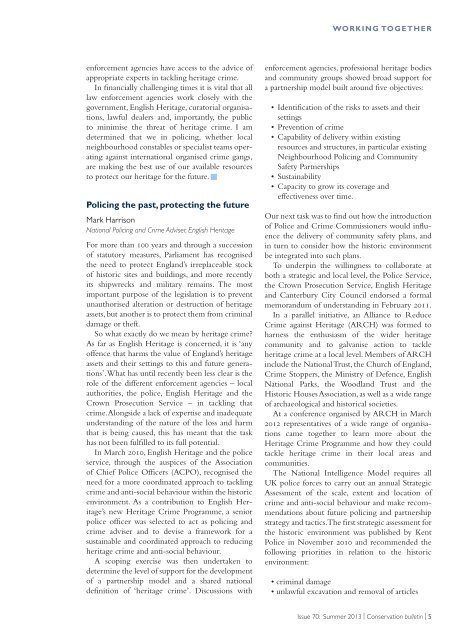Conservation Bulletin 70 | PDF - English Heritage
Conservation Bulletin 70 | PDF - English Heritage
Conservation Bulletin 70 | PDF - English Heritage
You also want an ePaper? Increase the reach of your titles
YUMPU automatically turns print PDFs into web optimized ePapers that Google loves.
WORKING TOGETHER<br />
enforcement agencies have access to the advice of<br />
appropriate experts in tackling heritage crime.<br />
In financially challenging times it is vital that all<br />
law enforcement agencies work closely with the<br />
government, <strong>English</strong> <strong>Heritage</strong>, curatorial organisations,<br />
lawful dealers and, importantly, the public<br />
to minimise the threat of heritage crime. I am<br />
determined that we in policing, whether local<br />
neighbourhood constables or specialist teams operating<br />
against international organised crime gangs,<br />
are making the best use of our available resources<br />
to protect our heritage for the future. ■<br />
Policing the past, protecting the future<br />
Mark Harrison<br />
National Policing and Crime Adviser, <strong>English</strong> <strong>Heritage</strong><br />
For more than 100 years and through a succession<br />
of statutory measures, Parliament has recognised<br />
the need to protect England’s irreplaceable stock<br />
of historic sites and buildings, and more recently<br />
its shipwrecks and military remains. The most<br />
important purpose of the legislation is to prevent<br />
unauthorised alteration or destruction of heritage<br />
assets, but another is to protect them from criminal<br />
damage or theft.<br />
So what exactly do we mean by heritage crime?<br />
As far as <strong>English</strong> <strong>Heritage</strong> is concerned, it is ‘any<br />
offence that harms the value of England’s heritage<br />
assets and their settings to this and future generations’.What<br />
has until recently been less clear is the<br />
role of the different enforcement agencies – local<br />
authorities, the police, <strong>English</strong> <strong>Heritage</strong> and the<br />
Crown Prosecution Service – in tackling that<br />
crime.Alongside a lack of expertise and inadequate<br />
understanding of the nature of the loss and harm<br />
that is being caused, this has meant that the task<br />
has not been fulfilled to its full potential.<br />
In March 2010, <strong>English</strong> <strong>Heritage</strong> and the police<br />
service, through the auspices of the Association<br />
of Chief Police Officers (ACPO), recognised the<br />
need for a more coordinated approach to tackling<br />
crime and anti-social behaviour within the historic<br />
environment. As a contribution to <strong>English</strong> <strong>Heritage</strong>’s<br />
new <strong>Heritage</strong> Crime Programme, a senior<br />
police officer was selected to act as policing and<br />
crime adviser and to devise a framework for a<br />
sustainable and coordinated approach to reducing<br />
heritage crime and anti-social behaviour.<br />
A scoping exercise was then undertaken to<br />
determine the level of support for the development<br />
of a partnership model and a shared national<br />
definition of ‘heritage crime’. Discussions with<br />
enforcement agencies, professional heritage bodies<br />
and community groups showed broad support for<br />
a partnership model built around five objectives:<br />
• Identification of the risks to assets and their<br />
settings<br />
• Prevention of crime<br />
• Capability of delivery within existing<br />
resources and structures, in particular existing<br />
Neighbourhood Policing and Community<br />
Safety Partnerships<br />
• Sustainability<br />
• Capacity to grow its coverage and <br />
effectiveness over time.<br />
Our next task was to find out how the introduction<br />
of Police and Crime Commissioners would influence<br />
the delivery of community safety plans, and<br />
in turn to consider how the historic environment<br />
be integrated into such plans.<br />
To underpin the willingness to collaborate at<br />
both a strategic and local level, the Police Service,<br />
the Crown Prosecution Service, <strong>English</strong> <strong>Heritage</strong><br />
and Canterbury City Council endorsed a formal<br />
memorandum of understanding in February 2011.<br />
In a parallel initiative, an Alliance to Reduce<br />
Crime against <strong>Heritage</strong> (ARCH) was formed to<br />
harness the enthusiasm of the wider heritage<br />
community and to galvanise action to tackle<br />
heritage crime at a local level. Members of ARCH<br />
include the National Trust, the Church of England,<br />
Crime Stoppers, the Ministry of Defence, <strong>English</strong><br />
National Parks, the Woodland Trust and the<br />
Historic Houses Association, as well as a wide range<br />
of archaeological and historical societies.<br />
At a conference organised by ARCH in March<br />
2012 representatives of a wide range of organisations<br />
came together to learn more about the<br />
<strong>Heritage</strong> Crime Programme and how they could<br />
tackle heritage crime in their local areas and<br />
communities.<br />
The National Intelligence Model requires all<br />
UK police forces to carry out an annual Strategic<br />
Assessment of the scale, extent and location of<br />
crime and anti-social behaviour and make recommendations<br />
about future policing and partnership<br />
strategy and tactics.The first strategic assessment for<br />
the historic environment was published by Kent<br />
Police in November 2010 and recommended the<br />
following priorities in relation to the historic<br />
environment:<br />
• criminal damage<br />
• unlawful excavation and removal of articles<br />
Issue <strong>70</strong>: Summer 2013 | <strong>Conservation</strong> bulletin | 5

















